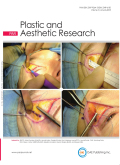- 钛学术文献服务平台 \
- 学术期刊 \
- 医药卫生期刊 \
- 外科学期刊 \
- 整形与美容研究(英文版)期刊 \
The interaction between hyaluronidase and hyaluronic acid gel fillers - a review of the literature and comparative analysis
The interaction between hyaluronidase and hyaluronic acid gel fillers - a review of the literature and comparative analysis
基本信息来源于合作网站,原文需代理用户跳转至来源网站获取
摘要:
Hyaluronic acid (HA) is the most common component of aesthetic fillers. Many formulations exist, each exhibiting properties that are manifestations of individual molecular modifications. The enzyme hyaluronidase degrades hyaluronic acid and can therefore be injected into soft tissue to reduce suboptimally placed HA fillers or to reverse local ischemic complications. The clinically available varieties of hyaluronidase may be derived from crude animal extracts or genetically engineered from recombinant human DNA. Different HA fillers are not uniformly dissolved by a single source hyaluronidase, and hyaluronidase from different sources may have varying efficacy in the degradation of HA. Previous studies of subsets of HA fillers and hyaluronidases have provided limited and often conflicting data regarding these differences, and a more comprehensive scientific study is needed. In this review, the authors describe commonly available formulations of HA and hyaluronidase and review all studies of HA-hyaluronidase interaction available via a PubMed and Google Scholar search from 2005 to present, exploring trends in the data. Factors determined to confer increased resistance to degradation included higher concentration of HA, higher crosslinking density, and status as monophasic versus biphasic. Fillers of the Juvéderm family were generally found to be more resistant to degradation than members of the Restylane family. Results are less consistent for Belotero Balance. No variety of hyaluronidase was consistently superior at dissolving any variety of HA filler. More research is needed to clarify these clinically relevant relationships.

推荐文章
An experimental study of interaction between pure water and alkaline feldspar at high temperatures a
Alkaline feldspar
Autoclave
High-temperature and high-pressure experiments
Discrimination geochemical interaction effects on mineralization at the polymetallic Glojeh deposit,
Backward Elimination
Quadratic polynomial model
Miniature-scale changes
Ordinal–disordinal interaction effect
Akima's polynomial contour map
Immobile element
A re-assessment of nickel-doping method in iron isotope analysis on rock samples using multi-collect
Fe isotope
Ni-doping
Stable isotope
Precision and accuracy
Mass bias correction
Pseudo-high mass resolution
Diffusion in garnet: a review
High temperature and high pressure
Diffusion
Garnet
Point defects
内容分析
关键词云
关键词热度
相关文献总数
(/次)
(/年)
文献信息
| 篇名 | The interaction between hyaluronidase and hyaluronic acid gel fillers - a review of the literature and comparative analysis | ||
| 来源期刊 | 整形与美容研究(英文版) | 学科 | |
| 关键词 | |||
| 年,卷(期) | 2020,(7) | 所属期刊栏目 | Review |
| 研究方向 | 页码范围 | 21-31 | |
| 页数 | 11页 | 分类号 | |
| 字数 | 语种 | 英文 | |
| DOI | 10.20517/2347-9264.2020.121 | ||
五维指标
引文网络
引文网络
二级参考文献 (0)
共引文献 (0)
参考文献 (26)
节点文献
引证文献 (0)
同被引文献 (0)
二级引证文献 (0)
2005(2)
- 参考文献(2)
- 二级参考文献(0)
2007(3)
- 参考文献(3)
- 二级参考文献(0)
2008(1)
- 参考文献(1)
- 二级参考文献(0)
2010(3)
- 参考文献(3)
- 二级参考文献(0)
2013(2)
- 参考文献(2)
- 二级参考文献(0)
2014(2)
- 参考文献(2)
- 二级参考文献(0)
2015(2)
- 参考文献(2)
- 二级参考文献(0)
2017(1)
- 参考文献(1)
- 二级参考文献(0)
2018(5)
- 参考文献(5)
- 二级参考文献(0)
2019(5)
- 参考文献(5)
- 二级参考文献(0)
2020(0)
- 参考文献(0)
- 二级参考文献(0)
- 引证文献(0)
- 二级引证文献(0)
引文网络交叉学科
相关学者/机构
期刊影响力
整形与美容研究(英文版)
主办单位:
出版周期:
月刊
ISSN:
2347-9264
CN:
开本:
出版地:
陕西省西安市高新区绿地SOHO B座1705室
邮发代号:
创刊时间:
语种:
eng
出版文献量(篇)
440
总下载数(次)
0
总被引数(次)
32
期刊文献
相关文献
推荐文献
- 期刊分类
- 期刊(年)
- 期刊(期)
- 期刊推荐
整形与美容研究(英文版)2022
整形与美容研究(英文版)2021
整形与美容研究(英文版)2020
整形与美容研究(英文版)2019
整形与美容研究(英文版)2018
整形与美容研究(英文版)2017
整形与美容研究(英文版)2016
整形与美容研究(英文版)2015
整形与美容研究(英文版)2014
整形与美容研究(英文版)2020年第9期
整形与美容研究(英文版)2020年第8期
整形与美容研究(英文版)2020年第7期
整形与美容研究(英文版)2020年第6期
整形与美容研究(英文版)2020年第5期
整形与美容研究(英文版)2020年第4期
整形与美容研究(英文版)2020年第3期
整形与美容研究(英文版)2020年第2期
整形与美容研究(英文版)2020年第12期
整形与美容研究(英文版)2020年第11期
整形与美容研究(英文版)2020年第10期
整形与美容研究(英文版)2020年第1期

 免费查重
免费查重










